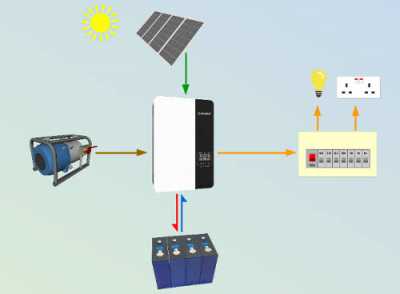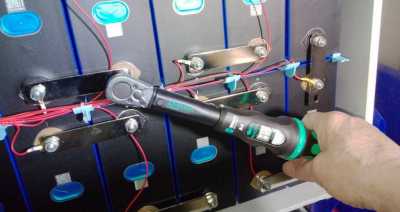Posted by: @transparentThe inverter in the middle is connected to the 240v grid.
But it cannot export back to the grid.
@transparent Thank you for bearing with me; I now see that the Growatt SPF 5000 ES connection to the grid is "AC Input" rather than "AC Input/Output", so the energy can never go back to the grid. Hence your system diagram has the one way arrow from grid to off-grid. It is simple once you know what is going on!
Also thanks for explaining your current setup(s). It is great that you are evaluating both on and off-grid options. The former looks to allow better load shifting as one does not have to provision for spikes (i.e. heat pump startups), whereas the latter has greater flexibility in choice of equipment and installer (within building/electrical regulations).
Posted by: @derek-mYou are obviously not fully aware of the capabilities of modern PLC's, which are used throughout industry
Yes, it's a good many years since I've worked with PLCs, and the technology has indeed got a great deal more sophisticated.
But I think the crucial word in your sentence is industry. I could, for example, use PLCs to replace the functionality of my electric and gas Smart Meters, my EV charge-point and the IHD. It would operate fine, but it's not the best approach to deploy into a residential environment.
There are two factors which I believe must be given greater significance in the design of the controller required:
- the user interface (or perhaps the lack of it!). Even an IHD is beyond what most households can put to useful effect. It must be intuitive.
- the way in which the home energy requirement must reflect the wider local distribution grid. Indeed it should dynamically respond to it in order to support the DNO's RIIO-ED2 objectives (reducing losses without massive infrastructure upgrades to be paid for with our standing-charges!)
Posted by: @batalto... a controller to do most of this via a raspberry pi. Certainly the forecasting part to optimise the charging on Go based on weather and sunshine.
I'm absolutely in agreement that Raspberry Pi is at the right sort of level to achieve what's required. It's excellent British technology.
It's a great shame that the stability of the ARM processor development and procurement is inadequate due to the way in which the ownership of ARM Holdings is being bounced around between Softbank, stock market investors, and its major customers. If our UK economy is to be rebuilt on technological innovation, then the government needs to secure a hold over this important asset.
And yes, I'm well aware of the API which allows Octopus customers to best utilise their Go & Agile ToU tariffs. I have discussed this with them. Let me make three observations:
1: Do you think that the use of the Octopus API affects the likelihood of customers wanting to switch to an alternative Energy Supplier? Is their approach transparent and portable to a rival supplier, if they should also offer a ToU tariff?
2: The Octopus data is transferred to their customers using the internet:
- Do your home devices remain operational if Octopus' server suffers a DOS attack (or even a sophisticated hack), and for how long?
- The tariff data is configured using UTC rather than the clock inside customers' Comms Hubs. How aware are you of the pricing 'errors' this creates for you? And how many customers can Octopus offer this technology to before the convergent device-switching creates surges (and hence losses) on the grid?
3: The ToU tariff structure is based on National Grid supply and demand data. It takes no account of regional or area statistics. Octopus Go might be offering me electricity at 30p/kWh at the same time as my area Grid Supply Point is over-subscribed with an abundance of renewable energy which is therefore discarded.
I really do like the company's approach, and the open access to the API & the algorithm used to calculate the tariff structure. This is streets ahead of the competition.
But I have to disagree with you that it is optimising your usage based on weather and sunshine. It is possibly doing so on price, but not environmental data.
Save energy... recycle electrons!
Posted by: @chickenbigThank you for bearing with me; I now see that the Growatt SPF 5000 ES connection to the grid is "AC Input" rather than "AC Input/Output"
The feedback you are providing here is vital if 'we' are going to better use energy resources. Every time that you (and others here) pick me up on a concept which I have inadequately explained, it leads me to re-visit diagrams and explanations.
Several years ago Ofgem identified that the lack of public knowledge/understanding about energy issues was holding us back from developing and deploying better technology. We simply have to get better at describing these concepts and discussing them with others.
In my diagrams and photos I make widespread use of labels, arrows, colours and fonts in an attempt to put the concepts across.
Please grab these images and take them with you next time you go to the pub! They are intended to provoke discussion and enable the public to better decide how they can tackle the energy crisis. 🙂
Save energy... recycle electrons!
In order to not 'crowd' this topic with ideas and information about the use of 'off-grid' storage batteries, I've started a separate thread about using a battery to drive Extra Voltage Devices directly (without using the inverter to re-create 240v AC).
Save energy... recycle electrons!
Posted by: @transparentAt this early stage I'm working with Growatt SPF5000ES hybrid units (5kW), but they are very difficult to get hold of. I currently have only one here. An order I first placed on 04feb22 for two more has still not yet been shipped from China. So be very wary of suppliers who will happily take your money and sit on it.
Yes, I am starting to see the attraction of this unit. The ability to parallel is desirable, plus it seems to be compatible with the Seplos BMS (with which we can also parallel the storage). Taking the house off grid is a fly in the ointment, but a friend knows an electrician who can deal with this.
I am currently trying to get quotes on Alibaba for the Growatt SPF5000ES (DDP, Trade Assurance only, delivery by 30 August 2022), and the quality of responses is highly variable. It seems that supply of these units is still quite tight (around 1/3 of RFC responses have proposed an alternative inverter). I have one supplier offering 847 USD DDP, another supplier 780 USD before duty/taxes (DDU?). Others are offering more in the 600 USD range. Some are proposing 'low invoice' to not attract import taxes (although they could just be more honest about the total price). I guess this is where the seller reputation (length of time on Alibaba, transaction value, Supplier Index rating) comes in.
Leaving aside the current problems in sourcing products from China at the moment, I think it might help if I also highlighted here what I've deduced from 'playing' with the SPF5000ES unit.
The firmware presents the user with a series of parameter settings which don't immediately lend themselves to the sort of off-grid use we are discussing here. I feel that Growatt's software engineers have started by imagining a typical off-grid homestead in the USA or Australian outback, which does not have a reliable grid connection (if any!).
Such a strategy can't be directly translated into its use on a ToU tariff from Octopus, for example.
Yes, the hardware is solid and excellent value for what it offers, but the SPF5000ES requires external control signals to re-fashion it into the mode of operation we are discussing here.
I too have been offered 'alternative' inverters from Chinese manufacturers and wholesalers. I'm evaluating these with a view to purchasing some units to test if it transpires that they might offer a better/easier configuration than the Growatt model.
Two that I have already checked out are unsatisfactory for the same reason as each other. In addition to an off-grid output, each of them also provided a 240v AC output which was synchronised to the mains grid.
Even if they had the required G98 certification for use in the UK, their maximum output would still be constrained by DNOs. The assumption would be that the export-limitation system within their firmware would not be trusted. As such they would be unable to offer the 30A or so needed to start a heat-pump. That's the benchmark I've set for a solution would be effective to meet Government targets for Nett-Zero by 2050.
Save energy... recycle electrons!
Posted by: @transparentthe SPF5000ES requires external control signals to re-fashion it into the mode of operation we are discussing here
Yes, I get the impression that were I to get the SPF5000ES the modbus protocol would be the way ahead (e.g. UtiChargeStart/UtiChargeEnd/MaxChargeCurr) although the semantics of the protocol could be much clearer. Being a software engineer I can see this is not a trivial problem to solve (system integration never is).
My thinking is drifting towards the house being an energy sink, that is never exporting energy back to the grid. SEG tarrifs don't seem too generous, and tariffs like Octopus Agile Outgoing require MCS approved systems. In my case the big savings to be had are to never export PV energy to the grid and to shift time of energy import into Economy 7; this would allow moving to using a heat pump at a relatively competitive price, provided the startup transients can be reliably dealt with.
I can understand why there is a desire to move energy between households and reduce the peaks and troughs. I'm not sure that purely a price signal will be enough for consumers, especially given the levels of investment (of time and money) required during these troubled times. One hopes the DNO energy efficiency mandate combined with increased EV uptake will go some way towards the solution.
@transparent Could I quickly ask about the no-load draw of the Growatt SPF5000ES. The manual lists it as < 60W; does this tie in with your experience? I'm planning on paralleling 2 (or perhaps 3) of these inverters to meet the peak power requirements.
I haven't yet looked at the efficiency of the Growatt SPF5000ES inverters @chickenbig
David Poz has made some observations related to this subject in his YouTube presentations. He comments on the fans being too noisy for him when the system is under heavy load. It's an important point. You would expect fans to be using a fair bit of energy themselves in addition to the heat-losses which they are dealing with.
As for your earlier comment about using Modbus... yes. But just note that Growatt do not offer commands which equate to "Import from grid" or "Directly connect the load(s) to grid". You have to implement these by interpreting the consequences of the higher-level preferences which they allow you to set.
It's also unlikely that you'll want to use the inbuilt 'clock' to configure when you want to take grid-electricity. They only allow this to be set per hour - no minutes. 😖
Save energy... recycle electrons!
@transparent after many delays I am finally ordering my 280ah cells from Brian and the Seplos DIY battery kit. Any feedback you have would be great. Also if you're interested happy sharing the feedback on the build of anyone wants to know.
Anyone near Hampshire who wants a fun day out, you're welcome to help me build it when all the kit arrives.
I think we'd all be interested to hear how the build progresses @batalto. Please take photos as you go in case someone later asks a question which could best be answered by uploading the graphic with an arrow or two!
Before the Seplos Mason box arrives, there's a few bits of bits of 'homework' you might wish to be pondering over:
- I'm pretty sure that the internal fuse is not a Type-T. In other words it will blow at the rated value ok, but isn't intended to rapidly blow open if a faulty inverter or other device goes short circuit. A Type-T has a chemical inside the ceramic body which is guaranteed to vapourise the wire link at 20kA or so. You should see this labelled "Rupture Capacity" or similar in the specifications.
- Look at a YouTube video of the assembly process and think how you can check that each adjacent pair of balance-wires has +3.2v between them before the balance-cables get connected to the BMS. Having one pair the wrong way around is the classic way to blow the BMS before you start!
- Have a think about how will avoid an accidental short-circuit during assembly by dropping a metal tool onto the cell terminals. I wire my LiFePO4 cells with them lying on-edge. The terminals then face outwards towards me, and tools fall to the floor away from the terminals.
- How are you going to supply no more than 8Nm torque to the terminal bolts? I have a 'low-torque' wrench made by Wera. But that'll set you back almost £150.
Don't wait until hardware starts arriving. The time to consider these points is now because it gives others a chance to discuss and make suggestions.
Save energy... recycle electrons!
Posted by: @transparentI'm pretty sure that the internal fuse is not a Type-T.
I confirmed with a Seplos tech-support person that these are 400A Zeeman ANMH fuses; they have an interrupt rating of 2,000A@80V DC. Has anyone performed testing around what interrupt capacity is actually required for LiFePO4 batteries; I understand that instantaneously 3.5/0.00025 = 14kA could be pushed through the cable, but I would expect voltage to drop/internal resistance to increase pretty quickly; does some form of Peukert's law apply to LiFePO4 too?
Please find attached a presentation on how to build the DIY box, to augment the youtube assembly video.
They do have a step for checking the BMS lead voltages, but there are no steps on cell balancing before construction of the battery, nor best practices for safety (tool insulation, eye protection), nor a torque setting in step 5.
- 26 Forums
- 2,396 Topics
- 54.3 K Posts
- 206 Online
- 6,077 Members
Join Us!
Worth Watching
Latest Posts
-
RE: Help me keep the faith with my air source heat pump installation
@simonf I’ll ask the installers to get them out. What k...
By AdamK , 7 hours ago
-
RE: Recommended home battery inverters + regulatory matters - help requested
Thanks for all the help/comments. I completely agree w...
By JamesPa , 9 hours ago
-
RE: ASHP Energy Consumption: Aira 12kW heat pump
I doubt that matters, ToU tariffs are for the benefit o...
By JamesPa , 15 hours ago
-

RE: Free Ecoheat Heat Pump Install
@deltona Yes older houses are problematic like that, bu...
By bontwoody , 17 hours ago
-
RE: Radiator sizing sanity check
As I mentioned early on the cost of supplying and fitti...
By JamesPa , 20 hours ago
-
RE: Advice for a novice on Mitsubishi Ecodan 6kW
I hadn't spotted that there were two pumps in the UFH (...
By JamesPa , 22 hours ago
-
RE: Setback savings - fact or fiction?
Never assume it makes an ass of u and me! You need the...
By JamesPa , 22 hours ago
-
RE: New Mitsubishi Ecodan 11.2kW installation - L9 errors and maybe more
Before I answer your specific questions just one more t...
By JamesPa , 22 hours ago
-
RE: Electricity price predictions
Great point, one of the key ones in my chat with Octopu...
By Batpred , 1 day ago
-
RE: Running from backup generaor in powercut?
Definitely and professionals sometimes miss it. I had...
By Batpred , 1 day ago
-

RE: New Fogstar 15.5kWh upright solution
Let me point out that there are many Chinese suppliers ...
By Transparent , 2 days ago
-

RE: Weather compensation- why you should use it
@majordennisbloodnok — The Two Ronnies Mastermind sketc...
By cathodeRay , 2 days ago
-
Just realised that this image of the cylinder cupboard ...
By Sheriff Fatman , 2 days ago
-

RE: Rodents! A word of warning for heat pump owners
Two thoughts: 1: Let's ask @david-s if Primary Pro in...
By Transparent , 2 days ago
-
RE: Solis S6-EH1P8K-L-PLUS – Why I Chose It and What I’ve Learned So Far
In the diagram below, I describe my understanding of th...
By Batpred , 2 days ago
-
I need to have a look out for it. I know IBM feeds some...
By Batpred , 2 days ago
-
-
RE: Daikin Atherma ASHP Cycling 6 Times an Hour?
Thanks for your reply. Yes that's a good idea to try a...
By John Marshall , 2 days ago
-

RE: Hot water heating in parallel with space heating
An external heat exchanger would need a pump which woul...
By bontwoody , 2 days ago
-
RE: Gen 6 Samsung ASHP losing 20C of DHW in 60 min directly after generation
@ecobaker Thanks for this. I've had it in both slots. ...
By andbeck , 2 days ago







